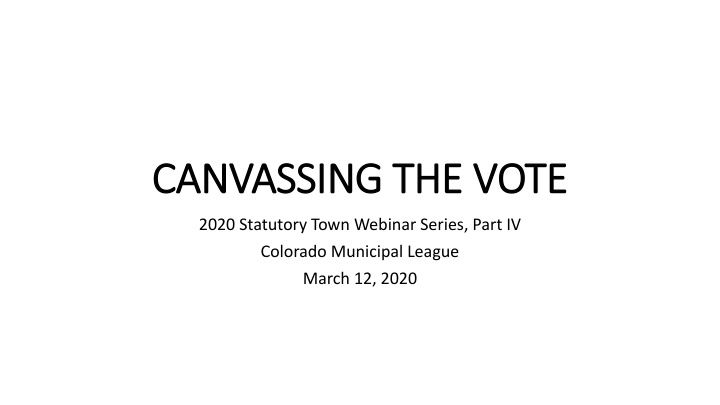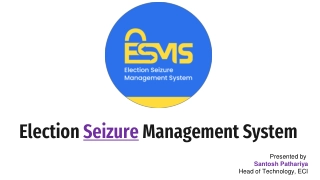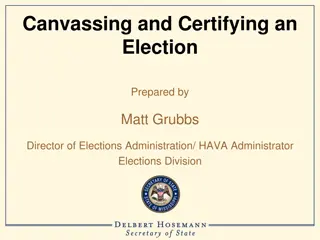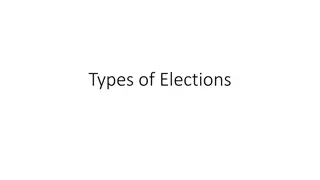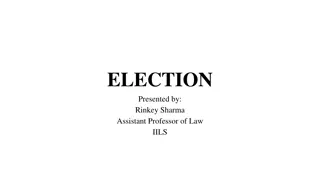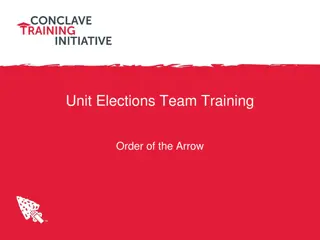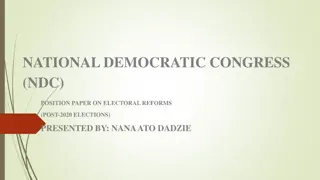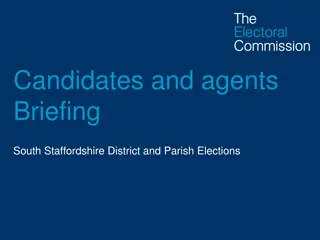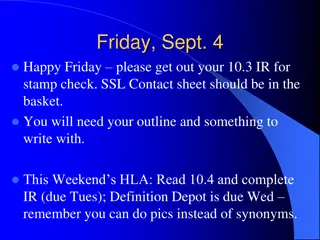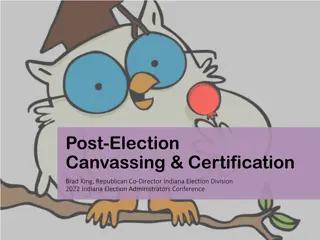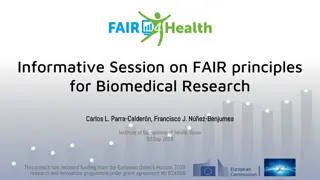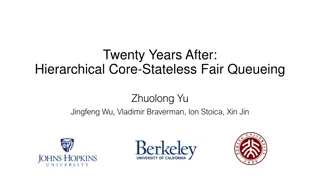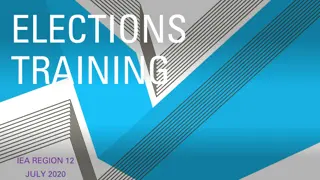Ensuring Fair Elections: The Canvassing Process Explained
Understanding the post-election canvassing process is crucial for verifying election results. After the polls close, election judges tally the votes, create necessary documentation, and prepare for the canvassing, where results are carefully reviewed and verified. Canvassing is not a recount but a diligent examination by the clerk and mayor or appointed officials. The process must be completed within specific timelines, ensuring all ballots are accounted for and discrepancies addressed.
Download Presentation

Please find below an Image/Link to download the presentation.
The content on the website is provided AS IS for your information and personal use only. It may not be sold, licensed, or shared on other websites without obtaining consent from the author.If you encounter any issues during the download, it is possible that the publisher has removed the file from their server.
You are allowed to download the files provided on this website for personal or commercial use, subject to the condition that they are used lawfully. All files are the property of their respective owners.
The content on the website is provided AS IS for your information and personal use only. It may not be sold, licensed, or shared on other websites without obtaining consent from the author.
E N D
Presentation Transcript
CANVASSING THE VOTE CANVASSING THE VOTE 2020 Statutory Town Webinar Series, Part IV Colorado Municipal League March 12, 2020
AFTER THE POLLS HAVE CLOSED AFTER THE POLLS HAVE CLOSED Election judges tally the votes and indicate the vote for all candidates and ballot items (using numbers) on a tally sheet. The tally sheet includes the following information: Number of ballots from ballot box (must match number of ballots distributed as listed in poll book Votes for each candidate and ballot item Place for judges initials Upon completing the count, a copy of the tally sheet, along with the counted ballots, shall be returned to the ballot box, sealed, and the seal initialed. Any ballots not counted, those for which votes cannot be determined or are overvotes and undervotes, shall be set aside. Election judges also create a judges certificate, which should be prepared prior to the election. The judges certificate, written in words, provides information on the voter for each candidate and ballot item. The language used on the judges certificate can be found in 31-10-613(1)
AFTER THE POLLS HAVE CLOSED AFTER THE POLLS HAVE CLOSED The judges shall prepare a third form containing the following information: Number of ballots delivered to voters Number of ballots voted Number of spoiled ballots Number of ballots not delivered to voters The judges shall prepare a fourth, and final form, the abstract of votes containing the following information: Names of offices Names of candidates, ballot titles and submission clauses of all items Number of votes counted for or against each candidate or measure The abstract of votes shall be posted in a conspicuous place on the outside of the polling location
CANVASS CANVASS Canvass: to examine carefully; scrutinize, to make a thorough examination (sometimes called survey ) The purpose of the canvass is to review the election results, as determined by the election judges, and to verify those results The canvass is NOT a recount. Canvass is conducted by clerk and mayor; if there is no mayor or the mayor was a candidate for election, clerk shall appoint: Municipal judge; or Member of the election commission or Person who is qualified to be an election judge and did not serve as one in the election CRS 31-10-1201
CANVASS ( CANVASS (cont cont) ) Canvass can be completed as early as election night, depending on circumstances shown below, and must be completed no later than 10 days after the election If ballots have been sent to UOCAVA-covered voters, the canvass cannot be completed until all possible ballots have been received (no later than 8 days after the election) If conducting a mail ballot election, the canvass cannot be completed until all discrepant signatures on the return envelopes have been cured (no later than 8 days after the election) Election results are considered to be unofficial until after the canvass has been completed. Elected candidates should not be sworn in until after the canvass has been completed.
CANVASS ( CANVASS (cont cont) ) Things to look for when conducting the canvass: Returns include all information required by law (substantial compliance is the standard) Omissions or clerical mistakes These shall be corrected by the judges of election 31-10-1203 Tie votes At the time of the canvass, tie votes are broken by lot when an equal number of votes for the same office have been received for the same office and there aren t enough offices remaining for all such candidates. Reasonable notice shall be given of the time when the tie will be broken. The need for a recount is determined at the time the canvass is performed and not before.
CERTIFICATE OF ELECTION CERTIFICATE OF ELECTION Once the canvass has been completed, clerk shall prepare a Certificate of Election, from the abstract of votes, that includes the following: Names of candidates Total votes cast for each candidate (absentee ballot votes can be in a separate column from those cast on election day) Signature of clerk and person who assisted clerk in the canvass Certificate of election is: Filed in municipal clerk s office Published in a newspaper of general circulation within the municipality (or posted if no such newspaper exists) Filed with the division of local government in the CO Dept. of Local Affairs 31-10- 1205
OVERLAPPING 4 OVERLAPPING 4- -YEAR TERMS OF OFFICE YEAR TERMS OF OFFICE If the election included 4-year overlapping terms and one of the candidates was being chosen to fill a vacancy that would not normally be filled at the election: The 4-year terms shall go to the candidates receiving the highest number of votes CRS 31-10-1205(1.5)
RECURRING ELECTION ISSUES RECURRING ELECTION ISSUES Criteria for including/excluding signatures on nomination petitions Election provisions in code at odds with state statute Pre-mature concerns about cancelling the election Handling write-in candidates Cancelling an election when both full and shortened terms are on the same ballot Difference between term of office and person who is in office Poor record keeping regarding the filling of vacancies, who is eligible to run, and term limits Unfamiliarity with election code provisions; reliance on others
